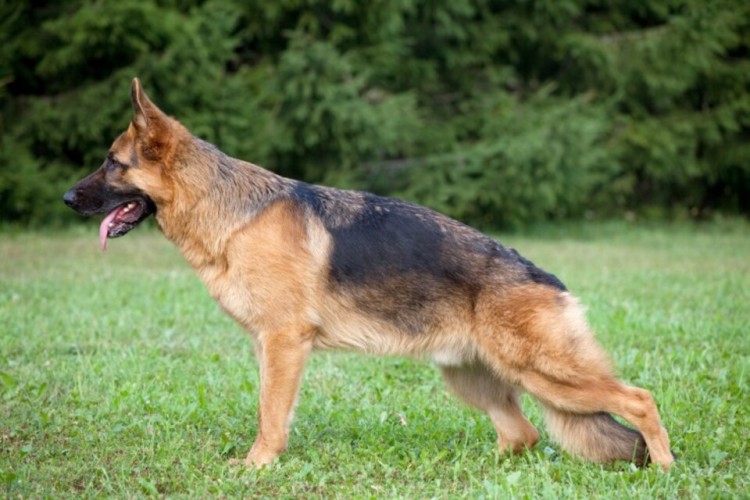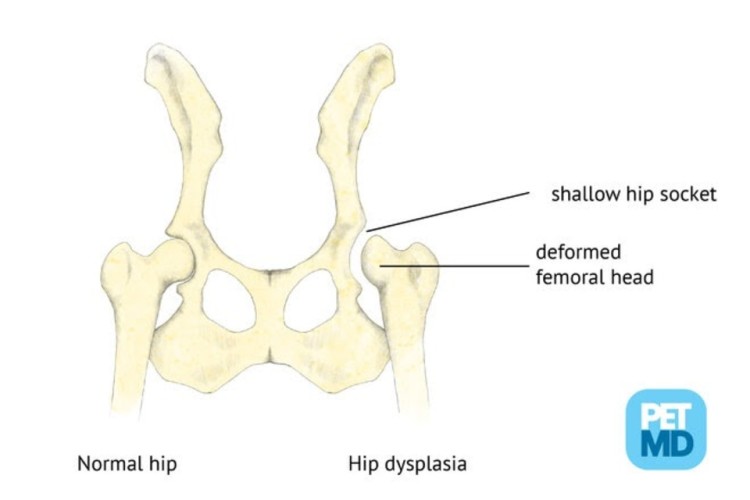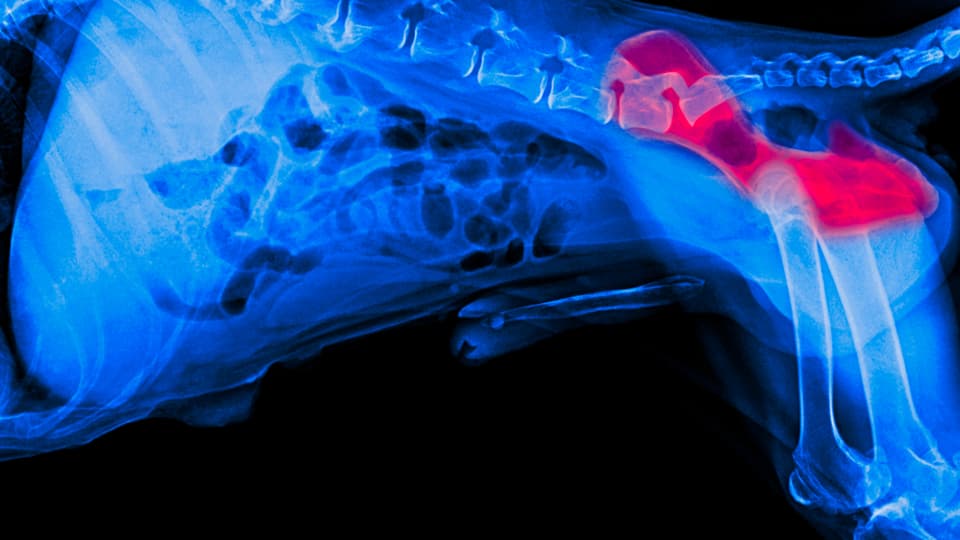Hip dysplasia is an inherited condition that is not easily fixed and can be painful and expensive to treat, but with the right care the pain can be minimized. In this post, you will learn everything you need to know about hip dysplasia, including the symptoms, treatment options, and prevention steps you can take in order to keep your pooch healthy and happy.
Table of Contents:
- What is Hip Dysplasia?
- Symptoms of Hip Dysplasia in Dogs
- How Is Hip Dysplasia Diagnosed?
- Treating Hip Dysplasia in Dogs
- What’s the Treatment Cost for Hip Dysplasia?
- How to Prevent Hip Dysplasia?
- Key Takeaways
Pro Tip: Many pet insurance plans will cover hip dysplasia no matter how old your dog is, as long as it’s not a pre-existing condition. This means that if your pup was showing signs of hip dysplasia prior to the start of his insurance policy, the condition will not be covered, so make sure to enroll before any issues arise.
 (Image source: Pets4Homes)
(Image source: Pets4Homes)
What is Hip Dysplasia?
Hip dysplasia is a genetic condition resulting from an improperly formed hip joint. The joint is loose, so the pup's bones move around too much within the joint, causing deterioration and, eventually, loss of joint function. This condition is the most common cause of osteoarthritis of the hip in dogs, a painful and crippling disease that can have a significant impact on your pup’s quality of life.
Pets with hip dysplasia usually start showing symptoms while they’re growing (at about five or six months of age) but can sometimes show no signs until much older. In general, the condition is worse in medium and large breed dogs (generally greater than 22 kg or 50 lbs), but it can happen to any size or breed of dog.
Other factors that worsen hip dysplasia in dogs include environmental factors, diet, exercise, hormones, growth rate, and muscle mass, which can magnify the genetic predisposition.
Since hip dysplasia is hereditary, certain breeds are affected more than others, including:
- Saint Bernard
- Bernese Mountain Dog
- Great Dane
- German Shepherd
- Golden Retriever
- Labrador Retriever
- Bulldog
- Old English Sheepdog
- Mastiff
- Rottweiler
- American Staffordshire Terrier
- Newfoundland
Symptoms of Hip Dysplasia in Dogs
Some canines begin to show symptoms of hip dysplasia when they are very young (at 4-5 months of age), while others develop it as they age, usually in conjunction with osteoarthritis.
In both cases, there are some symptoms that pet parents need to be aware of. The symptoms might vary depending on several factors, such as the level of inflammation, the severity of the disease, and how long your pet has suffered from it.
Symptoms include:
- Pain
- Swelling
- Stiffness
- Decreased range of motion
- Decreased activity
- Difficulty rising
- Rear-leg lameness
- Bunny-hopping gait
- Inability to exercise for longer periods of time
- Clicking sound from the hips when rising or moving
- Weight shifting to the front legs
- Difficulty climbing stairs or jumping
- Loss of muscle mass in the rear legs
- Lameness after exercise
- Progressive rear limb lameness
How Is Hip Dysplasia Diagnosed?
Your vet will perform a physical exam, manipulating your pet’s hind legs to check the looseness of the joint and see if there’s any pain, decreased range of motion, or grinding.
Your vet will also ask about your pup’s history, including previous health conditions, as well as possible injuries or incidents that might have contributed to the symptoms.They will also ask if the dog’s parents had any history of hip dysplasia.
The physical exam might also include blood work because the complete blood count can indicate inflammation caused by joint disease.
A definitive diagnosis, however, will be established with an X-ray or radiograph. Your vet will take radiographs of your pet’s hips to determine the severity of the condition, as well as the best treatment option for your canine companion.
 (Image source: PetMD)
(Image source: PetMD)
Treating Hip Dysplasia in Dogs
When it comes to hip dysplasia in dogs, there are several treatment options, ranging from changes in the lifestyle to surgical procedures. If the condition is not severe, your vet will probably recommend non-surgical treatment. Depending on your pup’s individual case, the treatment may include the following:
- Physical therapy
- Hydrotherapy
- Weight loss to reduce the stress on the hips
- A healthy diet and maintaining a normal weight
- Restriction of exercise
- Non-steroidal anti-inflammatory medications
- Supplements like chondroitin and glucosamine
- Omega-3 fatty acid supplementation
Pro Tip: Massage and applying a warm water bottle for 15 minutes twice a day can also be very helpful, as can the use of a firm, orthopedic bed and sleeping in dry and warm areas.
Your pup might need more rest if the condition is causing discomfort and pain. Your vet will recommend a pain-relief program tailored to your pet, including pain-relief medication and a suitable exercise program. Moderate running, walking, or swimming can help strengthen the muscles around the joint. As a rule of thumb, you should avoid running for long distances or jumping.
There are also several different surgical options for hip dysplasia, but the most common ones include:
-
THR (Total hip replacement), used in pups older than a year. With this procedure, degenerated joint structures are removed and replaced with synthetic components. 90% - 95% of canines that have had this surgery manage to retrieve excellent function of the hip.
-
TRP (Triple pelvic osteotomy), an option for younger dogs in which conservative treatment options have failed. This procedure has an 80% to 90% success rate, with most patients regaining good function within three months, but it does require a skilled surgeon.
-
FHO (Femoral head ostectomy), a procedure where the top of the femur is removed to reduce painful rubbing within the hip joint. This surgical procedure is the last resort when all other treatments fail and other surgical procedures are not an option.
Alternative medicine treatments
Platelet-rich plasma, combining stem cells with hyaluronic acid, acupuncture, traditional Chinese medicine, and Class 4 laser have been used to treat hip dysplasia in canines with varying results.
There is not enough research that proves the effectiveness of these therapies for hip dysplasia, although the initial results are promising. Make sure to consult your vet before trying any alternative or complementary medical procedures to help your furry companion.
What’s the Treatment Cost for Hip Dysplasia?
The cost of surgery for hip dysplasia in dogs can be anywhere between $1,200 to $7,000 per hip, depending on various factors, such as the type of procedure, your pup's condition, as well as their age, size, and overall health. If both joints are affected and your dog needs a THR surgery, it can cost up to $14,000, including pre-surgical bloodwork, anesthesia, post-surgical care, and medications.
Beyond surgery, your pet might require a lifetime of supplements and pain-relief medications, which can mount up to thousands of dollars over your pup’s lifetime.
Think about insuring your furry friend before any signs of illness start. Having dog health insurance will provide all the support you need to care for your pet if they develop a condition like hip dysplasia.
How to Prevent Hip Dysplasia?
Hip dysplasia cannot be prevented but there are some measures you can take to decrease the impact of hip dysplasia on their quality of life.
As the condition is most commonly seen in larger breed pups, these dogs should be kept at a healthy lean weight during growth. Feeding your canine companion an appropriate diet will ensure healthy joint and bone development and prevent abnormal strain on the hip joint which can make it worse.
As your pup grows, appropriate exercise will also help prevent obesity, which is another major factor in the severity of hip dysplasia your pet experiences Not to mention, obesity may cause a plethora of other health issues in dogs, including diabetes, heart disease, and hypertension.
Pups with hip dysplasia often lead long and happy lives, especially with appropriate treatment and lifestyle changes.
If your pet is diagnosed with hip dysplasia they should not be bred as they can pass this trait onto future puppies.
Key Takeaways
- Hip dysplasia is a condition that causes one or both hip joints to develop abnormally while a dog is growing.
- The condition most commonly affects medium to large breed dogs, causing swelling, stiffness, and pain.
- Treating hip dysplasia involves pain relief, weight control, and careful exercise but severely affected dogs might also require surgery.
- If you suspect your four-legged companion might be affected, make sure to talk to your vet.
